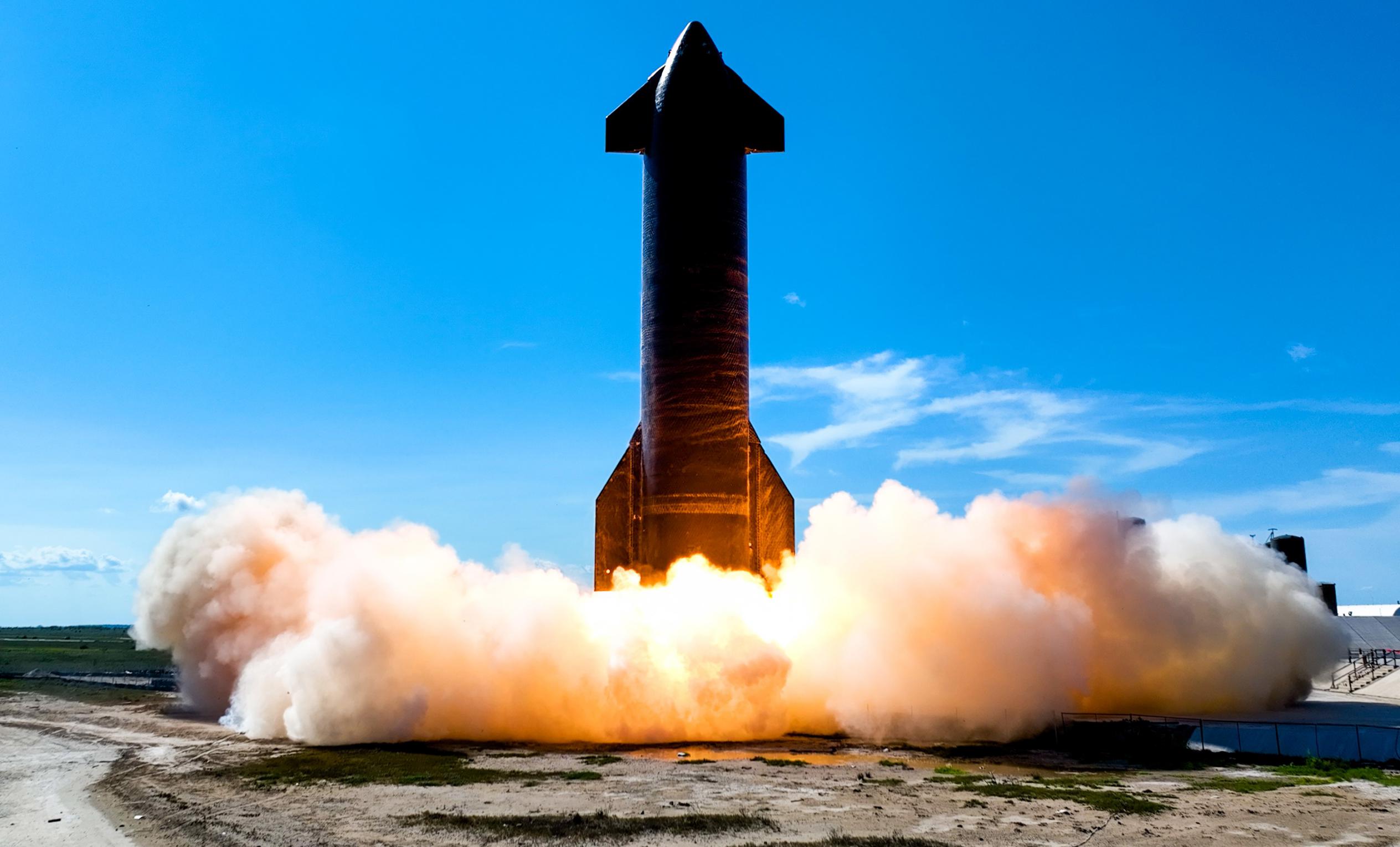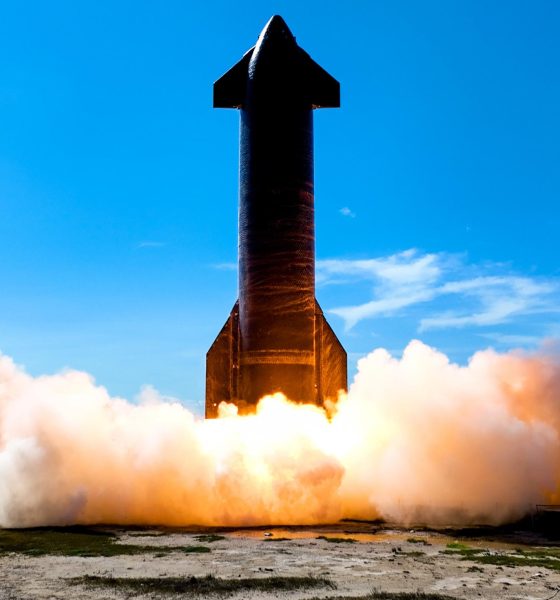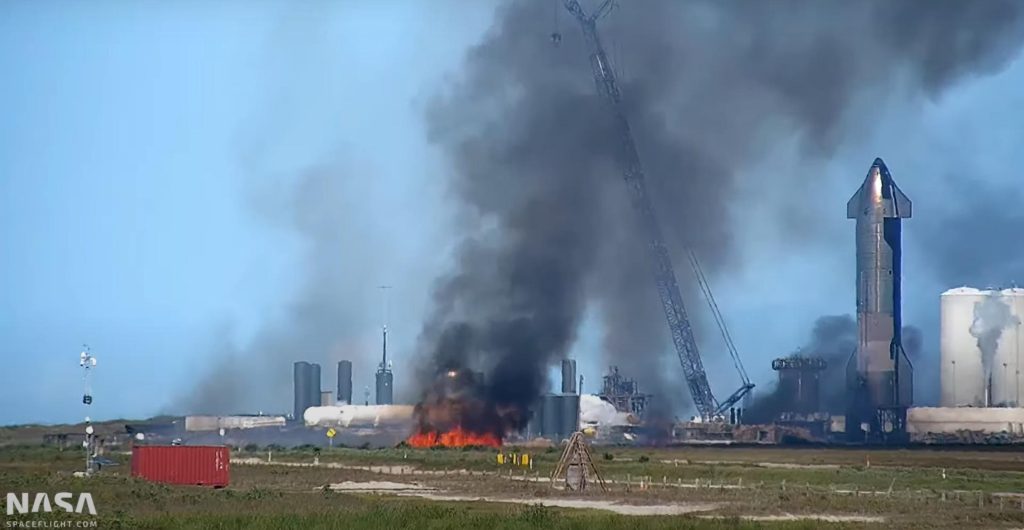

News
SpaceX Starship prototype ignites six engines, starts major brush fire
SpaceX has successfully ignited all six engines on its latest Starship prototype, taking a significant step towards ensuring that the upper stage will be ready for the rocket’s first orbital launch attempt.
Unfortunately, the same successful static fire of a Starship upper stage – potentially producing almost twice as much thrust as the booster of SpaceX’s Falcon 9 rocket – scattered superheated debris hundreds of meters away, igniting a major brush fire. It’s not the first major fire caused by Starship activities in South Texas, and it likely won’t be the last.
Starship S24 completed its first successful static fire on August 9th, igniting two Raptor engines. Several unsuccessful attempts to test more engines followed throughout the rest of the month, and SpaceX ultimately decided to replace one of Starship S24’s three Raptor Vacuum engines in early September before trying again. After workers installed the new engine and buttoned up Ship 24, the stars eventually aligned on September 8th.
Kicking off the test, SpaceX pumped several hundred tons of liquid oxygen (LOx) and a much smaller quantity of liquid methane (LCH4) fuel into Ship 24 in about 90 minutes, producing a crisp layer of frost wherever the cryogenic liquids touched the skin of the rocket’s uninsulated steel tanks. No frost formed on Starship’s upper methane tank, implying that SpaceX only loaded methane fuel into internal ‘header’ tanks meant to store propellant for landings. The hundreds of tons of liquid oxygen, then, were likely meant as ballast, reducing the maximum stress Starship could exert on the test stand holding it to the ground.
That potential stress is substantial. Outfitted with upgraded Raptor 2 engines, Starship S24 could have produced up to 1380 tons (~3M lbf) thrust when it ignited all six for the first time at 4:30 pm CDT. On top of smashing the record for most thrust produced during a Starbase rocket test, Ship 24’s engines burned for almost 8 seconds, making it one of the longest static fires ever performed on a Starship test stand.
Several brush fires were visible almost immediately after clouds of dust and steam cleared. More likely than not, the combination of the extreme force, heat, and burn duration likely obliterated the almost entirely unprotected concrete surface below Ship 24. Despite continuous evidence that all Starship static fire operations would be easier and safer with the systems, SpaceX still refuses to install serious water deluge or flame deflector systems at Starbase’s test stands and launch pads.
Instead, under its steel Starship test stands, SpaceX relies on a single middling deluge spray nozzle and high-temperature concrete (likely martyte) that probably wouldn’t pass muster for a rocket ten times less powerful than Starship. In multiple instances, Starships have shattered that feeble martyte layer, creating high-velocity ceramic shards that damage their undersides or Raptor engines, requiring repairs and creating risky situations. With essentially no attempt at all to tame the high-speed several-thousand-degree Raptor exhaust, static fire tests at Starbase thus almost always start small grass fires and cause minor damage, but those fires rarely spread.

Ship 24’s first six-engine test was not so lucky, although the Starship made it through seemingly unscathed. Most likely, eight long seconds of blast-furnace conditions melted the top layer of surrounding concrete and shot a hailstorm of tiny superheated globules in almost every direction. Indeed, in almost every direction there was something readily able to burn, a fire started. In several locations to the south and west, brush caught fire and began to burn unusually aggressively, quickly growing into walls of flames that sped across the terrain. To the east, debris even made it into a SpaceX dumpster, the contents of which easily caught fire and burned for hours.
Eventually, around 9pm CDT, firefighters were able to approach the safed launch pad and rocket, but the main fire had already spread south, out of reach. Instead, they started controlled burns near SpaceX’s roadblock, hoping to clear brush and prevent the fire (however unlikely) from proceeding towards SpaceX’s Starbase factory and Boca Chica Village homes and residents.
The nature of the estuary-like terrain and wetlands means that it’s very easy to stop fires at choke points, so the fire likely never posed any real threat to Boca Chica residents, SpaceX employees, or onlookers. It was also unlikely to damage SpaceX’s launch facilities or return to damage Starship S24 from the start, as both of are surrounded by a combination of concrete aprons, empty dirt fields, and a highway.
Still, the “brush” burned by the fire is a protected habitat located in a State Park and Wildlife Refuge. While fire is a natural and often necessary element of many habitats, including some of those in Boca Chica, this is the second major brush fire caused by Starship testing since 2019, which may be less than desirable. At a minimum, fighting fires around Starbase generally requires firefighters to walk or even drive on protected wetlands and salt flats, the impact of which could ultimately be as bad for wildlife and habitats as the fire itself.
SpaceX’s Federal Aviation Administration (FAA) Programmatic Environmental Assessment (PEA), which fully greenlit the company’s existing Starbase Texas facilities and launch plans earlier this year, only discusses fire [PDF] a handful of times. Repairing and preventing future damage to wetlands, however, comes up dozens of times and is the subject of numerous conditions SpaceX must meet before the FAA will grant Starship an orbital launch license.
Ultimately, given that the FAA approved that PEA in full awareness of a 2019 brush fire caused by Starhopper (an early Starship prototype) that may have been as bad or worse than 2022’s, there’s a chance that it will play a small role in the ongoing launch licensing process, but the odds of it being a showstopper are close to zero. Still, it would likely benefit SpaceX at least as much as the surrounding Boca Chica wilderness if it can implement changes that prevent major brush fires from becoming a regular ‘accidental’ occurrence.

Investor's Corner
Tesla price target boost from its biggest bear is 95% below its current level

Tesla stock (NASDAQ: TSLA) just got a price target boost from its biggest bear, Gordon Johnson of GLJ Research, who raised his expected trading level to one that is 95 percent lower than its current trading level.
Johnson pushed his Tesla price target from $19.05 to $25.28 on Wednesday, while maintaining the ‘Sell’ rating that has been present on the stock for a long time. GLJ has largely been recognized as the biggest skeptic of Elon Musk’s company, being particularly critical of the automotive side of things.
Tesla has routinely been called out by Johnson for negative delivery growth, what he calls “weakening demand,” and price cuts that have occurred in past years, all pointing to them as desperate measures to sell its cars.
Johnson has also said that Tesla is extremely overvalued and is too reliant on regulatory credits for profitability. Other analysts on the bullish side recognize Tesla as a company that is bigger than just its automotive side.
Many believe it is a leader in autonomous driving, like Dan Ives of Wedbush, who believes Tesla will have a widely successful 2026, especially if it can come through on its targets and schedules for Robotaxi and Cybercab.
Justifying the price target this week, Johnson said that the revised valuation is based on “reality rather than narrative.” Tesla has been noted by other analysts and financial experts as a stock that trades on narrative, something Johnson obviously disagrees with.
Dan Nathan, a notorious skeptic of the stock, turned bullish late last year, recognizing the company’s shares trade on “technicals and sentiment.” He said, “From a trading perspective, it looks very interesting.”
Tesla bear turns bullish for two reasons as stock continues boost
Johnson has remained very consistent with this sentiment regarding Tesla and his beliefs regarding its true valuation, and has never shied away from putting his true thoughts out there.
Tesla shares closed at $431.40 today, about 95 percent above where Johnson’s new price target lies.
News
I subscribed to Tesla Full Self-Driving after four free months: here’s why
It has been incredibly valuable to me, and that is what my main factor was in considering whether to subscribe or not. It has made driving much less stressful and much more enjoyable.

I have been lucky enough to experience Tesla Full Self-Driving for the entire duration of my ownership experience for free — for four months, I have not had to pay for what I feel is the best semi-autonomous driving suite on the market.
Today, my free trial finally ran out, and I had two choices: I could go without it for a period until I felt like I absolutely needed it, or I could subscribe to it, pay $99 per month, and continue to experience the future of passenger transportation.
I chose the latter, here’s why.
Tesla Full Self-Driving Takes the Stress Out of Driving
There are a handful of driving situations that I don’t really enjoy, and I think we all have certain situations that we would just rather not encounter. This is not to say that I won’t ever experience them as someone who has driven a car for 15 years (it feels weird saying that).
I don’t love to drive in cities; I really don’t like driving on I-695 on my way to Baltimore, and I truly hate parallel parking. All three things I can do and have done, all three within the past few weeks, too.
It takes all the stress out of city driving pic.twitter.com/q0SPPrH4HU
— TESLARATI (@Teslarati) December 4, 2025
However, if I can avoid them, I will, and Tesla Full Self-Driving does that for me.
Tesla Full Self-Driving Eliminates the Monotony
I drive to my alma mater, Penn State University, frequently in the Winter as I am a season ticket holder to Wrestling and have been for 16 years now.
The drive to State College is over two hours and over 100 miles in total, and the vast majority of it is boring as I travel on Rt 322, which is straight, and there is a lot of nature to look at on the way.
I am willing to let the car drive me on that ride, especially considering it is usually very low traffic, and the vast majority of it is spent on the highway.
The drive, along with several others, is simply a boring ride, where I’d much rather be looking out the windshield and windows at the mountains. I still pay attention, but having the car perform the turns and speed control makes the drive more enjoyable.
Tesla Full Self-Driving Makes Navigating Easier
Other than the local routes that I routinely travel and know like the back of my hand, I’ve really enjoyed Full Self-Driving’s ability to get me to places — specifically new ones — without me having to constantly check back at the Navigation.
Admittedly, I’ve had some qualms with the Nav, especially with some routing and the lack of ability to choose a specific route after starting a drive. For example, it takes a very interesting route to my local Supercharger, one that nobody local to my area would consider.
But there are many times I will go to a new palce and I’m not exactly sure where to go or how to get there. The Navigation, of course, helps with that. However, it is really a luxury to have my car do it for me.
To Conclude
There was no doubt in my mind that when my Full Self-Driving trial was up, I’d be subscribing. It was really a no-brainer. I am more than aware that Full Self-Driving is far from perfect, but it is, without any doubt, the best thing about my Tesla, to me.
It has been incredibly valuable to me, and that is what my main factor was in considering whether to subscribe or not. It has made driving much less stressful and much more enjoyable.
🚨 How I’ve gotten Tesla Full Self-Driving for free…until now
Watch me subscribe to Tesla FSD! https://t.co/bjK7EEOptR pic.twitter.com/cs5CmN5PdJ
— TESLARATI (@Teslarati) January 7, 2026
News
Tesla Diner becomes latest target of gloom and doom narrative

The Tesla Diner has been subject to many points of criticism since its launch in mid-2025, and skeptics and disbelievers claim the company’s latest novel concept is on its way down, but there’s a lot of evidence to state that is not the case.
The piece cites anecdotal evidence like empty parking lots, more staff than customers during a December visit, removed novelty items, like Optimus robot popcorn service and certain menu items, the departure of celebrity chef Eric Greenspan in November 2025, slow service, high prices, and a shift in recent Google/Yelp reviews toward disappointment.
The piece frames this as part of broader Tesla struggles, including sales figures and Elon Musk’s polarizing image, calling it a failed branding exercise rather than a sustainable restaurant.
This narrative is overstated and sensationalized, and is a good representation of coverage on Tesla by today’s media.
Novelty Fade is Normal, Not Failure
Any hyped launch, especially a unique Tesla-branded destination blending dining, Supercharging, and a drive-in theater, naturally sees initial crowds taper off after the “Instagram effect” wears down.
Tesla makes major change at Supercharger Diner amid epic demand
This is common for experiential spots in Los Angeles, especially pop-up attractions or celebrity-backed venues. The article admits early success with massive lines and social media buzz, but treats the return to normal operations as “dying down.”
In reality, this stabilization is a healthy sign of transitioning from hype-driven traffic to steady patronage.
Actual Performance Metrics Contradict “Ghost Town” Claims
- In Q4 2025, the Diner generated over $1 million in revenue, exceeding the average McDonald’s location
- It sold over 30,000 burgers and 83,000 fries in that quarter alone. These figures indicate a strong ongoing business, especially for a single-location prototype focused on enhancing Supercharger experiences rather than competing as a mass-market chain
It’s not a ghost town lol. The @Tesla Diner still had over 30,000 burger orders and 83,000 fries orders in Q4. The diner generated over $1M in revenue in Q4, a $4M annual run rate, which is more than the average McDonald’s…. pic.twitter.com/XvAGLUqxej
— Sawyer Merritt (@SawyerMerritt) January 4, 2026
Conflicting On-the-Ground Reports
While the article, and other similar pieces, describe a half-full parking lot and sparse customers during specific off-peak visits, other recent accounts push back:
- A January 2026 X post noted 50 of 80 Supercharger stalls were busy at 11 a.m., calling it “the busiest diner in Hollywood by close to an order of magnitude
TESLA DINER 🍔
Frantic!!!
Crazy busy. pic.twitter.com/wMbmr8SFFn
— Rich & Sharon (@HullTeslaModel3) January 4, 2026
- Reddit discussions around the same time describe it as not empty when locals drive by regularly, with some calling the empty narrative “disingenuous anti-Tesla slop.”
When we visited it last week it was packed. We had to wait to enter, get a table and go to the restroom. We were lucky to find a spot to charge.
— Rani G (@ranig) January 4, 2026
Bottom Line
The Tesla Diner, admittedly, is not the nonstop circus it was at launch–that was never sustainable or intended. But, it’s far from “dying” or an “empty pit stop.”
It functions as a successful prototype: boosting Supercharger usage, generating solid revenue, and serving as a branded amenity in the high-traffic EV market of Los Angeles.








